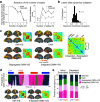Cognitive and Neural State Dynamics of Narrative Comprehension
- PMID: 34531284
- PMCID: PMC8549535
- DOI: 10.1523/JNEUROSCI.0037-21.2021
Cognitive and Neural State Dynamics of Narrative Comprehension
Abstract
Narrative comprehension involves a constant interplay of the accumulation of incoming events and their integration into a coherent structure. This study characterizes cognitive states during narrative comprehension and the network-level reconfiguration occurring dynamically in the functional brain. We presented movie clips of temporally scrambled sequences to human participants (male and female), eliciting fluctuations in the subjective feeling of comprehension. Comprehension occurred when processing events that were highly causally related to the previous events, suggesting that comprehension entails the integration of narratives into a causally coherent structure. The functional neuroimaging results demonstrated that the integrated and efficient brain state emerged during the moments of narrative integration with the increased level of activation and across-modular connections in the default mode network. Underlying brain states were synchronized across individuals when comprehending novel narratives, with increased occurrences of the default mode network state, integrated with sensory processing network, during narrative integration. A model based on time-resolved functional brain connectivity predicted changing cognitive states related to comprehension that are general across narratives. Together, these results support adaptive reconfiguration and interaction of the functional brain networks on causal integration of the narratives.SIGNIFICANCE STATEMENT The human brain can integrate temporally disconnected pieces of information into coherent narratives. However, the underlying cognitive and neural mechanisms of how the brain builds a narrative representation remain largely unknown. We showed that comprehension occurs as the causally related events are integrated to form a coherent situational model. Using fMRI, we revealed that the large-scale brain states and interaction between brain regions dynamically reconfigure as comprehension evolves, with the default mode network playing a central role during moments of narrative integration. Overall, the study demonstrates that narrative comprehension occurs through a dynamic process of information accumulation and causal integration, supported by the time-varying reconfiguration and brain network interaction.
Keywords: causality; cognitive neuroscience; default mode network; fMRI; functional connectivity; narrative comprehension.
Copyright © 2021 the authors.
Figures








References
Publication types
MeSH terms
LinkOut - more resources
Full Text Sources
